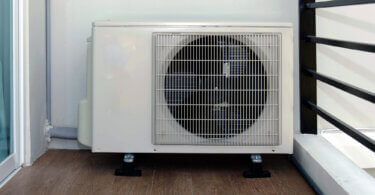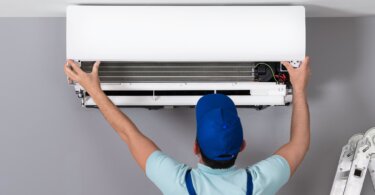As our cities become more populated, there are a lot of basements and windowless apartments that many are taking up for accommodations.
But many times, such rooms have a ventilation problem.
Being in a room that has no windows during the summer can be very painful if you don’t even have climate control.
Unfortunately, any air conditioner that you might think of buying, even a portable one, itself needs to be vented.
So it becomes a chicken and egg story – you need an AC because there is no ventilation, but you can’t have one without some way to vent it!
What is the way out? Well, here are some ideas that will work.

Why Do Portable Air Conditioners Need to Be Vented?
First things first – why do ACs need venting? Can you do without it?
The answer, as you might have expected, is no. To understand this, you must first learn how an AC works.
An AC unit brings down the temperature of a room. Most ACs work on the same technology. They pull in hot air, which gets absorbed by a refrigerant.
This coolant is then sent into a compressor coil, which extracts heat from it. A fan expels the hot air that is generated in the process.
For larger ACs, this hot air is expelled through a hose that runs outside the windows. But for smaller, portable air conditioning units, this is not an option.
That said, the hot air is still being created, so it is important to let it out from somewhere. Otherwise, it’s simply going to come back into the room and destroy all the good work done by your AC.
Now let’s get to the actual solutions.
Venting Your AC Through a Hole in the Wall
If you can’t have a window, you can at least make a hole in the wall large enough to run the AC’s hose through it!
Well, it is not that simple.
Drilling holes in walls is normally best left to the professionals.
But if you are a DIY kind of person, here are a few things you should take note of.
Choosing the right wall
- Steel and reinforced concrete walls are a big no-no. You will just end up destroying your drilling bit.
- Moreover, before selecting the right wall, have a look at the building map.
- Figure out the thickness of the wall you are trying to drill a hole in. Avoid choosing thicker walls.
- Make sure you are not touching any supporting beams and studs that are crucial to the structural integrity of the building.
- Check for pipes and wiring running through the walls.
Making the hole
After you have ensured the above, measure the diameter of your hose pipe.
The trick is to have a hole that’s not larger than the hose pipe. Otherwise, you will end up needlessly having to add filler to the wall.
Mark out the dimensions of your spot before you begin, and only drill as much as necessary. You can also use a circular saw if you don’t have a drill.
Lastly, there might be a little bit of space left around the hose despite all the precautions above.
In such cases, seal the remaining portion with insulation and silicone caulking.
What about interior walls?
In some cases, the wall you are making a hole in might just be a separation wall, not an external one.
Maybe your room is in the middle of the home and does not have access to any external wall.
Or else the external walls are made of reinforced steel so they cannot be drilled into.
In either case, the effect of making a hole in the internal wall is that the heat will just fill up in a different room.
Now if that’s just a laundry room or something similar, it won’t be a problem.
But if that is another person’s room, they might not be ok with it.
In this case, you might have to make another hole in the second room’s external wall and run a long hose through it outside the home.
Venting Through a Door
One of the easiest ways to vent your AC is to run the venting hose through a door.
The best possibility would be to have a sliding door that leads outside the room to an open area.
Many portable ACs even come with a sliding door vent adaptation kit.
Here’s how to install one:
- Firstly, find out how many inches you need to run your hose through the sliding door.
- Add a couple of inches to the and push the sliding door ajar by that much.
- Take the panel provided with the AC kit (you can also buy one online) and fix it in the space between the door and the wall.
- Sometimes, the panels provided may not reach right to the top of the door. You can use wood or plexiglass to cover the remaining space.
If your door is not a sliding one, you might have to replace it with a less broad one and then install these panels in the space created.
Using A Ceiling Vent
In many offices that don’t have windows, using a ceiling vent is an excellent way to vent a portable air conditioner.
However, this only works if the office space has a drop ceiling.
Essentially the space above the drop ceiling is unutilized. It might even have cable or other things running through it.
For venting a portable AC, simply buy a drop ceiling kit.
It will essentially replace a single panel from your drop ceiling with a long chimney-like attachment that can be connected to your AC’s venting hose.
These kits are pretty easy to install and quite effective. Most of them can be as long as ten feet or more, so they work in almost any kind of room or office space.
Using the Dryer Vent
If you are installing your portable AC in the dryer room or a room that has a dryer vent but has been converted to a different purpose, the dryer vent can become a venting space for your AC as well.
There is really no difference between the venting hose of a portable AC and a dryer – they are nearly the same dimensions and sizes.
All you need to do is to plug in your venting hose in the dryer vent, and voila, you’re done.
Unfortunately, this usually limits the space in which you can keep or move your AC around to within six feet of the dryer vent, which may not be ideal.
The easy fix to that is just to get a longer hose.
You might find ones that are longer than even 20 feet available online. Be aware: this does reduce the energy efficiency of your device a little bit.
However, the loss of a bit of energy is alright as long as your room is colder since, without venting, the AC would anyways have to use up extra energy to cool the room.
Using a Chimney
Chimney venting is fairly uncommon. For one thing, most houses don’t have them. Even if they do, the chimney itself needs to be unused.
Secondly, installing a hose that runs all the way through the house and goes through the chimney in itself is extremely complex.
It requires a pretty long hose too.
I would suggest that you get an expert professional to install a hose that long in your house.
What To Do If None of That Works?
At times, it is possible that none of the above ways to vent your portable AC are feasible.
For example, if you are on a rented property, your landlord might simply not allow you to modify anything in the building, such as making a hole in the wall.
In such cases, what are the alternatives available to you? Here are some options that you can consider:
- Use an evaporative cooler (or a portable swamp cooler) instead. It works by using the heat in the air to evaporate water, which means that it does not produce hot air at all.
- Use a couple of table fans, which might be a good idea if the heat is not too oppressive.
- Use natural ways to keep your room cooler. For example, switch off unnecessary electric devices and lighting.
I’ve created a list with more tips in my article How To Cool a Room With No Windows.
Tip: check out my suggestion for the Best Ventless Portable Air Conditioner
Run Your AC in Dehumidifier Mode
This is one trick that might work in those places where there simply isn’t any option to run a hose outside.
Just change your AC to dehumidifier mode (in some cases, it would be mentioned as “dry”). Now, fix a garden hose to the AC’s drain port (not the exhaust port) because it would generate water vapor.
Then simply put the other end of the hose into a bucket or let it drain into a nearby drain.
Wrap Up
It is important to ensure that your portable air conditioner is vented outside. The way they work produces hot air, and if not vented properly, it would end up causing the room to keep getting hotter even though the AC is running.
If there are no windows, you can do it either through a hole in the wall, running the hose through a door, using a ceiling vent, or any of the options that I outlined above.
If none of these things are possible, it would be best to reconsider getting a portable AC that needs a hose. I would suggest you get a swamp cooler or a table fan instead.





Leave a Comment